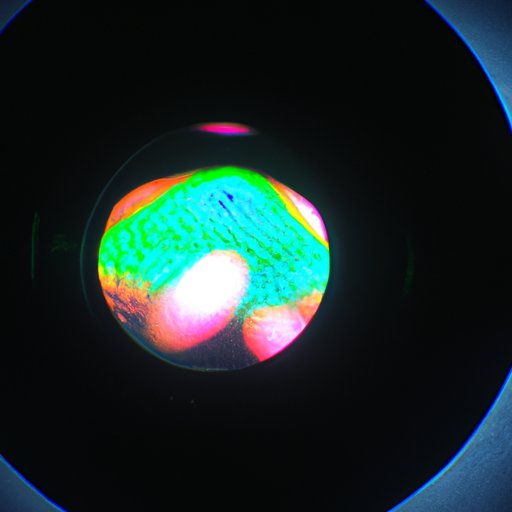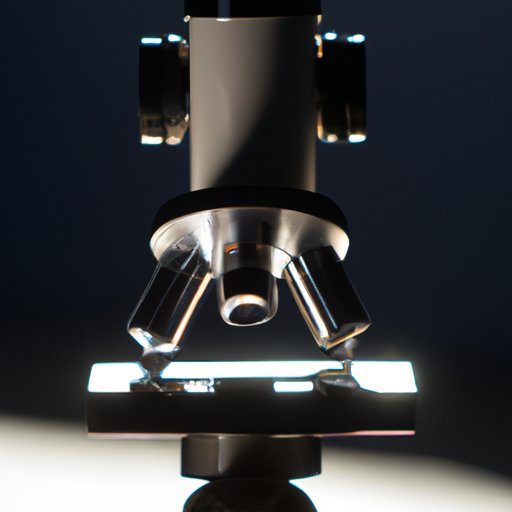Introduction
A microscope is an instrument used to observe objects that are too small to be seen with the naked eye. It uses lenses and other optics to magnify the image and make it visible to the observer. Microscopes come in many shapes and sizes, from simple hand-held models to large laboratory instruments. They can be used to view a variety of objects, from cells to crystals.
Definition of a Microscope
A microscope is a scientific instrument designed to magnify objects that are too small to be seen by the unaided eye. It works by using lenses to bend, refract, and reflect light in order to magnify the image of the object being viewed. The objective lens of a microscope gathers the light from the specimen and focuses it onto the eyepiece lens, which then further magnifies the image. This allows the observer to see details that would otherwise be invisible.
Overview of the Different Types of Microscopes
There are several types of microscopes available, each designed for different purposes. Compound microscopes are the most common type, and they use two or more lenses to magnify the image. These are best suited for viewing specimens that are too small to be seen with the naked eye. Stereo microscopes use two separate objectives to provide three-dimensional images, while electron microscopes use beams of electrons instead of light to magnify objects. Lastly, digital microscopes use a digital camera to capture images and display them on a computer screen.
A Step-by-Step Guide to Using a Microscope
Using a microscope is not as difficult as it may seem. Here is a step-by-step guide to setup and use a microscope:
Exploring the Parts of a Microscope
Before you begin using a microscope, it is important to familiarize yourself with its parts. The eyepiece is the part that you look through in order to view the specimen. The objective lens is the lens closest to the specimen, and it is responsible for gathering light from the specimen and focusing it onto the eyepiece. The arm of the microscope is the part that holds the objective lenses, and the stage is the platform where the specimen is placed. Finally, the focus knob is used to adjust the focus of the microscope.
Setting Up a Microscope
Once you have identified the parts of the microscope, you can begin setting it up. First, place the microscope on a stable surface and make sure it is level. Place the specimen on the stage and use the focus knobs to bring the image into focus. Adjust the eyepiece so that it fits comfortably against your eye. Make sure that the light source is on and adjusted correctly before you begin observing the specimen.
Adjusting the Focus
The focus knobs are used to adjust the focus of the microscope. To focus the image, start with the lowest magnification and slowly adjust the knobs until the image is clear. Once the image is in focus, you can increase the magnification if needed. When you are finished observing the specimen, make sure to turn the focus knobs back to their starting position.
Taking Care of Your Microscope
It is important to take care of your microscope in order to ensure it lasts for years to come. After each use, make sure to clean the lenses and the stage with lens cleaning solution and a soft cloth. Be careful not to touch the lenses with your fingers as this can cause damage. Additionally, make sure to store the microscope in a cool, dry place when not in use.

How Light Modifies Images Through a Microscope
Light plays a crucial role in how a microscope works. It is essential for forming an image of the specimen being viewed. As light passes through the objective lens, it is bent and focused onto the eyepiece. This allows the observer to see a magnified version of the specimen. According to research published in the journal Nature Photonics, “light is bent and focused by the microscope’s optics, allowing the observer to view a magnified version of the specimen.”
Describing the Magnifying Power of a Microscope
The magnifying power of a microscope is determined by the number of times the image is enlarged. For instance, a microscope with a 10x objective lens will magnify the image ten times larger than it appears to the naked eye. Different types of microscopes have different magnifying powers, ranging from 50x to 1000x. The higher the magnification, the greater the detail you will be able to see in the specimen.
Examining the Uses of a Microscope
Microscopes are a valuable tool in science and medicine. They are used to study cells and other microorganisms, diagnose diseases, analyze chemicals, and much more. They can also be used for hobbies such as coin collecting and stamp collecting. Microscopes can even be used to repair electronics and inspect the quality of manufactured goods.
Conclusion
Microscopes are an invaluable tool for scientists, doctors, hobbyists, and more. By understanding how they work, you can make the most of your microscope and get the most out of your observations. With the right care and maintenance, your microscope can last for years to come. From examining cells to analyzing chemicals, a microscope is an essential tool for anyone who wants to explore the world around them.
Summary of the Benefits of Owning a Microscope
Owning a microscope comes with many benefits. It can help you explore the microscopic world and gain insight into the smallest of details. It can also be used for hobbies such as coin collecting and stamp collecting. Finally, microscopes are essential tools for medical professionals, scientists, and engineers, allowing them to make discoveries and develop new technologies.
Final Thoughts on the Topic
No matter what your purpose for using a microscope, understanding how it works is essential. By following the steps outlined in this article, you can set up and use your microscope with confidence. With the right care and maintenance, your microscope can be a faithful companion for years to come.
(Note: Is this article not meeting your expectations? Do you have knowledge or insights to share? Unlock new opportunities and expand your reach by joining our authors team. Click Registration to join us and share your expertise with our readers.)
